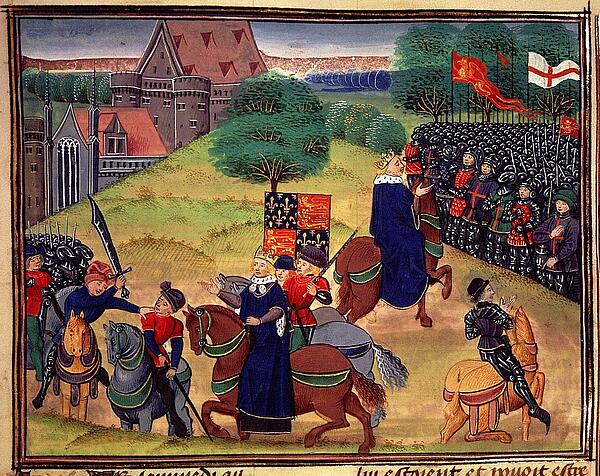Peasants Revolt
There were very few revolts in Medieval England and the Peasants’ Revolt in June 1381 is considered by historians to be the worst case on record.
During the Medieval period, criminals faced such harsh punishments that a warning was often enough to prevent such revolts from occurring. Many notable locations in England also had castles filled with soldiers, making it unlikely peasants would consider rebelling.
However, in 1381 a peasant army from Kent and Essex successfully made its way into London and took the Tower of London captive. The Archbishop of Canterbury and the King’s Treasurer were both killed, and a 14-year-old King Richard II went to meet with peasants at Mile End to discuss their concerns.

There were a number of reasons why the peasants had decided to ride into London:
- Firstly, as a result of the Black Death there were far few workers in the manors. In order to encourage their workers, many lords decided to let them go free and provide them with payment for their work in exchange for continuing loyalty. However, almost 35 years later, many peasants were beginning to worry that their lords would withdraw the privileges they had become used to, and were set to fight for their new rights.
- Many peasants were expected to work for free on church land for up to two days each week, leaving them unable to focus on the land that would provide their families with food. The peasants wanted to be free from this agreement and were given support by a Kent-based priest called John Ball.
- Richard II introduced a new tax known as the Poll Tax in 1380, which required every person on the tax register to pay 5p. The king asked for this tax to be paid three times in four years, and by 1381 the peasants were beginning to resent paying such a large sum to their king. Some were even forced to give away their seeds or tools if they couldn’t pull together the 5p, which resulted in serious problems later in the year.
In May 1381, a tax collector arrived in the village of Fobbing in Essex to discover why many peasants had neglected to pay their taxes, but villagers threw him (and the soldiers who arrived a month later) out. This marked the start of a turning point for the peasants, with surrounding villages beginning to follow suit.
It wasn’t long before a large group of peasants from across the region came together to oppose the king, led by Wat Tyler from Kent. A march towards London began, with peasants taking the opportunity to destroy tax records and government buildings as they went.
By mid-June, the peasants had begun to forget their original intentions and many spent their time getting drink and looting. Some were even known to murder any foreigners they came across in the city.
On 14 June, the young king made the decision to meet with the peasants at Mile End to discuss providing them with their demands in exchange for their departure. While this appealed to some, many decided to return to London and murder the Archbishop and Treasurer, cutting off their heads on Tower Hill as the king hid.
Still desperate to reach an agreement, Richard met with the peasants once more on 15 June at Smithfield. This is believed to have been the idea of Sir William Walworth, Lord Mayor, who wanted to remove the peasants without force to avoid fire in the wood-based city.
During the meeting with the Lord Mayor, Wat Tyler was killed. Although the events of the meeting are unclear, Tyler’s demise and the repeated promises of King Richard II encouraged the peasants to return to their homes.
The revolt finally ended in the summer of 1381, marked by hanging of John Ball and a declaration from the king that his promises were made under threat and so were not lawfully valid. Although the poll tax was withdrawn, the peasants were still forced to return to their lives under the control of the lord of their manor.
However, the Black Death had still left a mark on the labour force. Over the coming century, many peasants found they were able to demand more from their lords as a result of the small supply for workers.
See also: The Poor Peasant
MLA Citation/Reference
"Peasants Revolt". HistoryLearning.com. 2026. Web.
